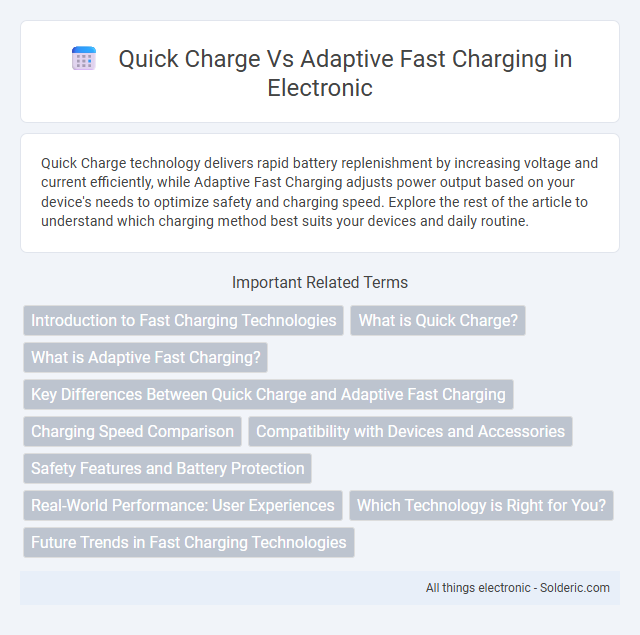Quick Charge technology delivers rapid battery replenishment by increasing voltage and current efficiently, while Adaptive Fast Charging adjusts power output based on your device's needs to optimize safety and charging speed. Explore the rest of the article to understand which charging method best suits your devices and daily routine.
Comparison Table
| Feature | Quick Charge (QC) | Adaptive Fast Charging (AFC) |
|---|---|---|
| Developer | Qualcomm | Samsung |
| Compatibility | Wide range of devices supporting QC-enabled chips | Primarily Samsung devices and compatible accessories |
| Charging Speed | Up to 27W (QC 3.0 and 4.0 versions) | Up to 15W |
| Voltage Range | 3.6V to 20V (variable) | 5V to 9V |
| Backward Compatibility | Supports older USB charging standards | Compatible with standard USB chargers |
| Device Negotiation | Dynamic voltage adjustment for optimal power delivery | Fixed voltage steps for charging adjustment |
| Usage | Popular in many Android devices beyond Samsung | Used mainly in Samsung Galaxy and related devices |
Introduction to Fast Charging Technologies
Fast charging technologies like Quick Charge and Adaptive Fast Charging significantly reduce smartphone charging time by increasing the power output beyond standard levels. Qualcomm Quick Charge, widely used in many Android devices, offers multiple versions supporting up to 27W or more, optimizing voltage and current to deliver rapid energy transfer. Samsung's Adaptive Fast Charging dynamically adjusts the charging speed based on battery status and temperature, ensuring efficient and safe power delivery tailored to device needs.
What is Quick Charge?
Quick Charge is a proprietary fast charging technology developed by Qualcomm, designed to significantly reduce charging time for compatible devices by increasing voltage and current levels. It supports a range of versions, from Quick Charge 1.0 to Quick Charge 5, each offering improvements in power efficiency and charging speed, with Quick Charge 5 capable of delivering up to 100W. Quick Charge is widely used in smartphones, tablets, and other portable electronics, ensuring rapid battery replenishment compared to standard charging methods.
What is Adaptive Fast Charging?
Adaptive Fast Charging is a proprietary technology developed by Samsung that dynamically adjusts the charging voltage and current based on the device's battery status, ensuring faster and safer battery charging. It optimizes power delivery by detecting the device's charge capacity and temperature, preventing overheating and maximizing charging efficiency. Compatible mainly with Samsung devices, Adaptive Fast Charging is similar to Qualcomm's Quick Charge but tailored to Samsung's hardware specifications.
Key Differences Between Quick Charge and Adaptive Fast Charging
Quick Charge utilizes Qualcomm's proprietary technology designed to deliver higher voltage levels for faster charging speeds, while Adaptive Fast Charging is Samsung's optimized solution that dynamically adjusts voltage and current based on the device's requirements. Quick Charge supports a broader range of devices across various brands, whereas Adaptive Fast Charging is primarily tailored for Samsung smartphones and compatible gadgets. Understanding these key differences helps you select the most efficient fast charging method for your specific device and ensures optimal battery performance.
Charging Speed Comparison
Quick Charge technology offers significantly faster charging speeds by delivering higher voltage and current than Adaptive Fast Charging, which typically maxes out around 15W. Quick Charge 3.0 can charge devices up to 80% in about 35 minutes, whereas Adaptive Fast Charging usually requires closer to 50 minutes for the same battery level. Devices supporting Quick Charge benefit from more efficient power delivery and reduced heat generation during rapid charging sessions.
Compatibility with Devices and Accessories
Quick Charge technology supports a wide range of devices from various manufacturers, ensuring compatibility with many Android smartphones, tablets, and accessories. Adaptive Fast Charging is primarily designed for Samsung devices, providing optimized charging speeds for compatible Galaxy models and accessories. Both technologies use USB Power Delivery protocols but differ in voltage and current adjustments tailored to their respective device ecosystems.
Safety Features and Battery Protection
Quick Charge and Adaptive Fast Charging both incorporate advanced safety features like temperature control, voltage regulation, and overcharge protection to safeguard your device's battery health during rapid charging cycles. Quick Charge technology often includes dynamic adjustments to power delivery based on battery temperature and capacity, minimizing risks such as overheating or battery degradation. Your device's longevity is maintained by these intelligent safety protocols, ensuring efficient charging while protecting the battery from potential damage.
Real-World Performance: User Experiences
Quick Charge and Adaptive Fast Charging both deliver significantly faster charging speeds than standard chargers, but real-world performance often varies based on device compatibility and battery health. Users report that Quick Charge tends to maintain higher charging speeds longer during the session, while Adaptive Fast Charging can slow down sooner to protect battery longevity. Your experience will depend on your specific phone model and charger combination, with some users noting minimal perceived difference between the two technologies in everyday use.
Which Technology is Right for You?
Quick Charge offers faster power delivery ideal for compatible devices seeking rapid battery replenishment, while Adaptive Fast Charging provides a more balanced approach, optimizing charging speed based on device requirements and heat management. Choosing between Quick Charge and Adaptive Fast Charging depends on your smartphone model compatibility and the importance of charging speed versus battery longevity. Users with Qualcomm Snapdragon processors benefit most from Quick Charge, whereas Samsung device owners typically experience optimal performance with Adaptive Fast Charging.
Future Trends in Fast Charging Technologies
Quick Charge and Adaptive Fast Charging continue to evolve, with future trends emphasizing higher power delivery and improved efficiency for faster battery replenishment. Emerging technologies such as GaN (Gallium Nitride) chargers and integration with USB Power Delivery (USB-PD) protocols aim to support a broader range of devices at speeds exceeding 100W. Innovations in thermal management and smart charging algorithms also contribute to safer, more sustainable fast charging solutions for next-generation smartphones and electric vehicles.
Quick Charge vs Adaptive Fast Charging Infographic

 solderic.com
solderic.com